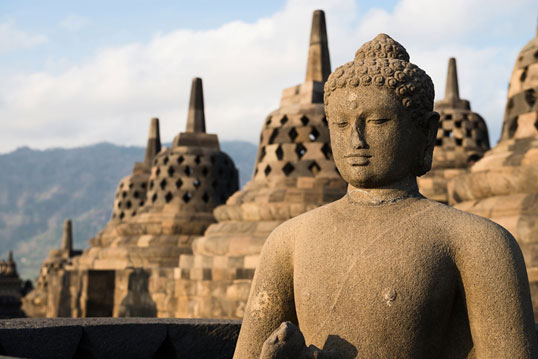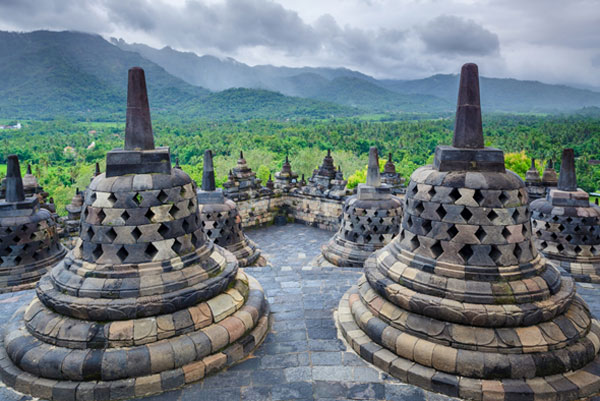The magnificent ancient Buddhist Temple of Borobudur
Indonesia is the country with the largest Muslim population in the world. Prior to the coming of Islam, however, this archipelago was dominated by Hinduism and Buddhism. One of the most iconic monuments attesting to this pre-Islamic era is the Borobudur Temple Compound in the Kedu Valley, which is situated on the southern part of Central Java.
The Borobudur Temple Compound consists of three monuments, namely the Temple of Borobudur and two smaller temples located on the east on a straight axis to the main temple. The main temple of Borobudur itself is the largest Buddhist temple in the world. This 60,000m³ monument is 34.5m high and has a square base of 123m x 123m. Borobudur was built in three tiers. The base of this temple consists of a pyramid formed by five concentric square terraces. This is followed by the trunk of a cone with three platforms. On the very top is a monumental stupa (a mound-like structure containing Buddhist relics). The walls and balustrades of Borobudur are decorated with fine low reliefs depicting various Buddhist scenes.

Borobudur. Source: BigStockPhoto
This temple was built as a Mahayana Buddhist temple around the8th and 9 th century A.D. by the Sailendra dynasty. This dynasty originated either from South India or Indochina. Their presence in Java helped establish the island as a centre of Buddhist scholarship and worship. This is evident in the fact that Chinese coins and ceramics have been found at the site, indicating that it pilgrims from as far away as China once visited this sacred site. In addition, these artefacts suggest that Borobudur was abandoned by the 16 th century A.D. This may be due to the fact that the arrival of Islam on Java during the 13 th and 14 th centuries A.D. shifted the centre of Javan life to the eastern part of the island. Nevertheless, Borobudur was left to decay on its own. Over the next couple of centuries, volcanic eruptions deposited ash on the site, and Borobudur was engulfed by the lush vegetation that grew out of the fertile volcanic ash.
Although Borobudur was a largely forgotten site, it would not remain so forever. In the early 19 th century, Sir Thomas Stamford Raffles, the British governor of Java (and the founder the city of Singapore), heard about Borobudur, and took an interest in it. Hence, an excavation was organised to uncover the temple. Whilst this excavation brought Borobudur back into the limelight, it was had damaging effects on it. By exposing the temple to the elements, the temple began to deteriorate further. Furthermore, stones were casually removed by villagers to be used as building materials, while Buddha heads and other treasures were removed by collectors to be sold to private and public collections around the world.

Borobudur. Source: BigStockPhoto
In 1948, the plight of Borobudur came to the attention of the newly formed Republic of Indonesia. As a result, the preservation of this cultural heritage became a central priority of the government. Two decades later, the “Save Borobudur” campaign was launched through the Indonesian government and UNESCO. This was one of the most ambitious international preservation projects ever attempted, as the monument’s lower terraces were completely dismantled so that each stone could be individually identified, catalogued, cleaned and treated for preservation. In addition, the relief panels were also cleaned and treated to withstand the elements. Furthermore, an extensive drainage system was put in place behind the walls and under the floors of the galleries to reduce erosion. Eight years and $25 million later, the restoration of Borobudur was finally completed. Nevertheless, conservation of this temple has to be continued over the years. For instance, just several months ago, Borobudur was threatened by the eruption of Mount Kelud. In order to protect the temple, some of the stupas were quickly covered in order to protect them from the volcanic ash.
The fact that this incredible Buddhist monument continues to be treasured and protected in a predominantly Muslim country, is testament to its significant value as a cultural and historical icon of Indonesia.
Featured image: The stupas of Borobudur. Source: BigStockPhoto.
By Ḏḥwty
References
Guinness World Records, 2014. Largest Buddhist Temple. [Online]
Available at: http://www.guinnessworldrecords.com/records-3000/largest-buddhist-temple/
Jakarta Globe, 2014. Borobudur, Other Sites, Closed After Mount Kelud Eruption. [Online]
Available at: http://www.thejakartaglobe.com/news/borobudur-other-sites-closed-after-mount-kelud-eruption/
Lonely Planet, 2014. Introducing Borobudur. [Online]
Available at: http://www.lonelyplanet.com/indonesia/java/borobudur
National Geographic Travel, 2014. Borobudur Temple Compounds. [Online]
Available at: http://travel.nationalgeographic.com/travel/world-heritage/borobudur-temple/
Sacred Destinations, 2014. Borobuur, Indonesia. [Online]
Available at: http://www.sacred-destinations.com/indonesia/borobudur
Treasures of the World, 2014. ... saving Borobudur. [Online]
Available at: http://www.pbs.org/treasuresoftheworld/borobudur/blevel_1/b6_saving.html
Wikipedia, 2014. Borobudur. [Online]
Available at: http://en.wikipedia.org/wiki/Borobudur




















Comments
i can't imagine having to catalog individual stones...it would be like a giant puzzle! i'm glad to hear that people have gone to great lengths to protect the site, so many sites have been turned upside down by people who just take, take, take...leaving nothing for future generations.
love, light and blessings
AB